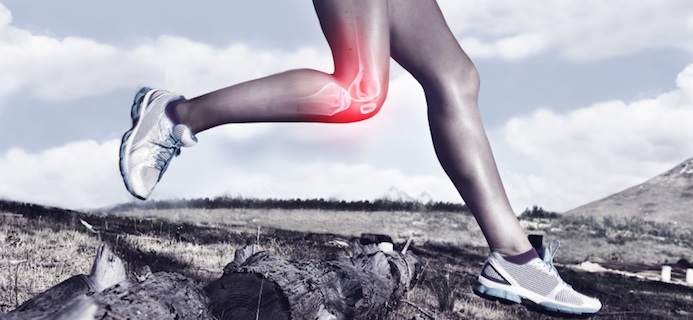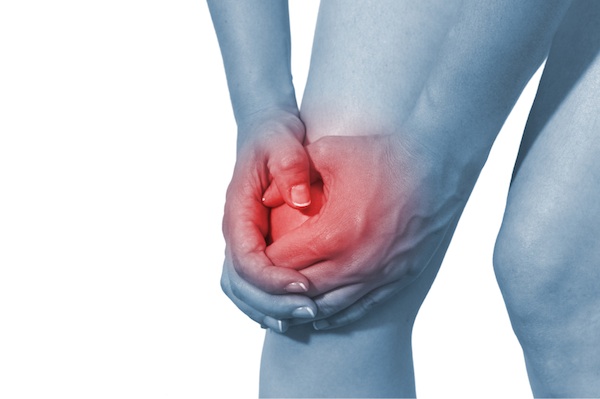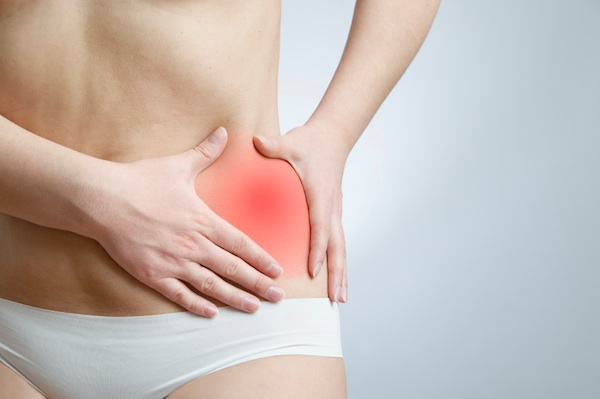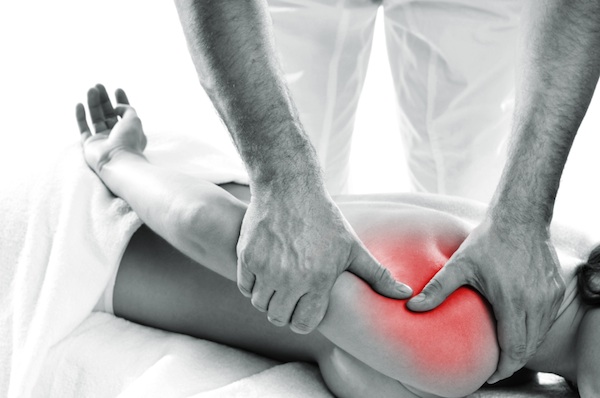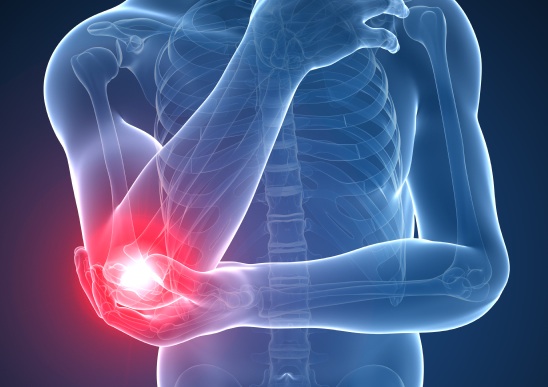Leading physiotherapist Tim Allardyce explains the key causes of joint pain for women over 40 and exactly how to prevent these niggles or deal with them when they strike
Most of my female patients are women between 40 and 75 and each day I see the same group of problems affecting their knees, hips, shoulders and elbows. The great news is that not only are these preventable using simple and quick exercises that you can work into your everyday life – no major lifestyle overhauls required – they can also be helped using a combination of natural supplements and targeted moves that minimise any niggles you’re feeling. This guide is based on the problems I see in the vast majority of my female patients over 40 and it’s filled with tiny joint-friendly changes you can start making today.
1. STIFF KNEES
Caused by: As we get older we tend to sit more and move less which causes a build up of synovial fluid that normally lubricates the knee, keeping it flexible. That means stiffness, pain and sometimes swelling.
Signs: You wake with sore knees or feel stiff after sitting for long periods, especially in tight seats such as at theatres or on planes. You may have pain at the front of your knee that gets worse when it bends.
Prevent it: Building up leg strength is essential to preventing knee pain as stronger muscles take the pressure off the knees, preventing pain. Build leg strength as you brush your teeth by stand on your left leg for one minute and then your right for the second minute (balancing on a wall if you need).
Got a niggle there already? For years doctors told people with stiff knees to rest more but the advice is now to get moving. The knee joint is designed for moving so take a dedicated 20 minute fast walk each day to build strength and make sure you add a few minutes walking up a gentle hill if you can. For pain, as you’re watching TV, do hot-cold therapy – use an ice pack for five minutes (this could be peas wrapped in a tea towel) on your knee, followed by a heat pack for 20 minutes which could be a hot water bottle or heat pads such as Thermacare Heat Wraps for Knees or Elbows (2 each) (£8.96)
Extra help: try a natural anti-inflammatory supplement such as Boswelia Serrata, a gum from the Indian Boswelia tree that has been shown in numerous studies, including double-blind placebo controlled trials to decrease joint pain after eight weeks of use. Try Viridian Boswellia Resin (£10.85 for 30). One to three daily.
2. TIGHT HIPS
Caused by: Sitting for long periods and lack of exercise and flexibility coupled with weak bottom muscles (that support the hip) can cause the hip to become stiff and immobile. This is an early form of osteoarthritis that if left untreated could eventually lead to needing hip replacement surgery.
Signs: Lie on the floor facing upward and bend one knee in. Can you bring your your knee to your chest? If not, and your knee only bends around 90 degrees, you may have the first signs of hip arthritis. Other signs include groin pain that spreads into your buttocks or down the front of your thigh and pain in the groin as you bend down to put on your shoes.
Prevent it: Do leg swings. While you’re standing at the cooker or waiting for the kettle to boil, hold onto the bench or rail and standing on one leg, swing the other leg across the body side to side, keeping your core tight. Do ten. Then swing the leg forward and back in the same way. Do another ten. Repeat on the other side ensuring you leg is straight and torso is relaxed but firm (don’t lean over!). Try and do these twice a day to help keep your hips flexible. Yoga too – especially the gentle ‘hatha’ a variety – emphasises opening the hips gently and slowly.
Got a niggle already? Practice hip bends. Lie on your back, bend your knee and pull it in towards your chest until you feel a stretch in your groin and buttock. Hold that for 20 or 30 seconds, breathing evenly. Do the same on the other leg. Try hat three times a day and you’ll find your flexibility increases every few days so you can move the knee a little further up towards your chest. Don’t jar or push yourself too far too soon or it could make the pain worse
Extra help: The herb Devil’s Claw has been shown to help alleviate pain from arthritis (and to work as well as some arthritis drugs) within 12 weeks. Try Healthspan Devil’s Claw Joint Aid (£13.95 for 60). Take one twice daily.
3. PINCHED SHOULDERS
Caused by: sitting at computers and laptops for long periods and hunching shoulders can lead to shoulder impingement syndrome, by far the most common shoulder issue I see in women. Really just a fancy name for pinched shoulders, the muscles underneath the shoulder blade become tight causing one or both sides to become stiff.
Signs: The first telling sign is usually being unable to do up your bra strap or even reach for it. Take action early as this gets progressively worse and can lead to an inability to lift the arms straight up over the head.
Prevent it: Practice door frame stretches throughout the day. Before you walk in through a doorway, put both arms straight up and grab the top of the doorframe with your fingertips (it might require tippy toes for people under five foot five!). Keeping your core engaged, walk a couple of tiny steps forward into the room or lean the body inwards until you feel a deep stretch along your underarm. Hold it for 10-30 seconds breathing evenly and repeat three times a day to maintain mobility in your shoulders (especially if you sit and stare at a screen all desk all day). If you can’t reach up to the door frame, do the same exercise with arms bent at right angles leaning your forearm on the side frame instead.
Got a niggle already? Do the bra strap exercise. Reach one arm behind you back towards your bra strap. Now, using your other hand gently ease your arm upwards. Hold for ten seconds, breathing evenly and repeat five times on each side. If you have this your arm won’t move far, perhaps millimetres, before you feel the niggle so don’t push through pain just make tiny movements (don’t worry these will help). Be gentle and ease the arm upwards rather than pulling it. Every few days you will notice your arm moving a tiny amount higher up your back – this is the shoulder opening; a good sign.
Extra help: Use an ice bag placed over the tip of the shoulder for 5-10 minutes twice a day. After 6-8 weeks this has been shown to help alleviate pinched shoulders successfully. Omega 3 fish oils can also help reduce the joint inflammation that can cause it by helping keep the joints lubricated and flexible. In fact, a meta-analysis of 68 studies on Omega-3 published in February this year concluded that taking Omega-3 supplements could help reduce joint inflammation. Try Healthspan Super Strength Omega 3 (£15.95 for 180).
4. TENNIS ELBOW
Caused by: Over-using the muscles of the fingers and forearms makes them short and tight. As these attach to tendons in the elbow they pull and the result is pain. But it’s not only caused by tennis. Any repetitive movements including using a mouse for hours a day, constantly carrying heavy shopping bags and even knitting can be culprits.
Signs: Holding everyday objects such as a kettle becomes painful. You might feel pain when squeezing things, opening jars or shaking hands or have increasing pain around the outside of the elbow.
Prevent it: Look at your daily movement and work patterns. Instead of using your laptop with your forearms bunched at your sides creating tension, let your elbows splay out a little so they can relax. Always use a wrist rest when you type on a keyboard and if you’re carrying shopping switch to a shoulder bag or trolley.
Got a niggle already? Try an ‘eccentric’ exercise which simultaneously contracts and lengthens the forearm muscle. Take a light weight (1-2 kg or a tin of beans) in your hand and place your forearm on a table, your wrist and hand holding the weight hanging over the edge. Let the hand with the weight in it drop down, so your wrist is bent. Now use your other hand to pick up your weight-holding hand and lift the wrist up. Do 10-20 of these with each hand, twice a day. Research has shown it’s one of the most effective exercises for Tennis Elbow.
Extra help: Try this easy acupressure tip. Bend your arm and find the fleshy bit just above your elbow, near the crease at the top of your forearm. As you watch TV press into this area gently with your thumb – it will feel tender on most people. Hold the pressure for 1-2 minutes on each side. Tennis Elbow comes from a lack of blood flow to the area and this stimulates it and helps relieve tension.
MORE from Tim Allardyce:
How to deal with ankle pain from injuries
Tim Allardyce is a physiotherapist who works with the Surrey Physiology Clinic. He specialises in sports physiology and osteopathy. Visit his company’s page at surreyphysio.co.uk or call 0208 685 6930
Like this article? Sign up to our newsletter to get more articles like this delivered straight to your inbox.



